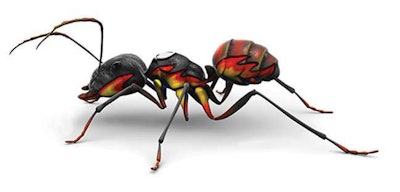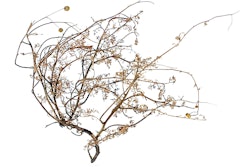
As fire ant populations dwindle in some southern states, another pest has been spreading like crazy.
Fire ants are no longer the hot topic they once were in Texas and along the southern coasts of the United States. Whether their numbers are in decline from efficient control measures or the past extreme hot and dry summers in those areas, the red imported fire ant has unwillingly passed the torch, so to speak, to a new Public Enemy No. 1.
“The big news is it’s not just about red imported fire ants anymore,” says Bastiaan “Bart” Drees, professor of entomology and extension specialist at Texas A&M University. “The new exotic invasive pest here in Texas is the Rasberry crazy ant, which we now call the tawny crazy ant. Where they occur, they run out the fire ants and can build up in great numbers.”
Drees says it’s not only tawny crazy ants that are exploiting the fact that red imported fire ant foraging has been suppressed. The Argentine ant is also taking this opportunity to expand its infestation in Texas and other areas.
Can this shift in power be such a bad thing? After all, red imported fire ants were once the most costly and hated invasive arthropods in the country, according to Dietrich Gotzek, post-doctoral research fellow at the University of Illinois. Even now, they are generally considered to be one of the worst invasive insects in the world, he says.
It can be a bad thing — especially if you’re stuck without a good method of control. “We have really good solutions for fire ants,” Drees says, “but very limited controls for (crazy and Argentine) ants.”
Spreading out
“Sudden, explosive outbreaks of unidentified pests are relatively rare, which is why the appearance of an unknown species of crazy ant … in 2002 near Houston, Texas, received extensive media coverage,” Gotzek says. “Particularly worrisome was the preliminary observation that this crazy ant can successfully compete with and even displace the red imported fire ant.”
 Tawny Ants
Tawny AntsSince then, that’s exactly what’s been happening. Populations of crazy ants and Argentine ants are exploding in new areas, and even harvester ants have been making a comeback and establishing themselves in great numbers in areas once known as fire-ant country.
“The controls for fire ants and the extreme weather has suppressed the fire ants during the past summers and opened a niche for other ants to colonize,” Drees says. “These ants are exploiting the fact that fire-ant foraging has been suppressed. There is a dynamic of one species over another.”
The tawny crazy ant has infested Texas, but it also has been positively identified in Louisiana, Florida and Mississippi, as well.
The Argentine ant has never been an outbreak pest in Texas before. “But now we’re seeing large infestations. Around the Lake Somerville area (just outside of College Station), we have a 300-acre spot of infestation, and we can’t get a handle on it. We’re getting more and more reports of large-scale infestations.”
Crazy ants originated in the Caribbean Islands and South America, Drees continues, and were introduced in one location in South America as a biological control agent. “They became so numerous there that chicken and poultry farms were dying because the ants were clogging their noses and causing asphyxiation.”
While the crazy ants on their own are not able to spread more than 300 feet or so a year, the transportation of the ants by humans poses the real threat of expansion of this pest. “They are tramp ants, and the movement of commerce by man is obviously moving these ants around,” Drees says. “That’s how the ant is able to jump from Houston to San Antonio, by the transportation of potted plants, construction equipment, etc. And because these ants have multiple queen colonies, these new pockets of infestation just grow like a cancer.”
Searching for control
Not having a centralized nest is what makes control options for these ants so difficult. With fire ants, treatments focused on the nest, killing the queen and killing the colony. With both tawny crazy ants and Argentine ants nesting laterally, it means developing a new way of thinking about control.
 Argentine Ant
Argentine Ant“Tawny and Argentine ants build up in great numbers because there is no central nest. They nest at the edge of every landscape element. Every surface in the landscape becomes covered in ants,” Drees says. “You can’t stand there without ants crawling on you.”
Typical control tactics do not work for these ants. In fact, tawny crazy ants aren’t even attracted to most tested bait products.
“We really have limited controls. Neither (tawny nor Argentine ants) responds to conventional fire-ant bait products. If you try to battle with these, you can actually make the infestation worse by knocking out competing ants,” he says.
For Argentine ants, even those controls that have proven effective won’t work on the infestations for logistical reasons. “Here in Texas, our Argentine ant infestations are often over large areas. Liquid bait stations in these situations are unfeasible. We have been working with the Army Corps of Engineers to assess granular bait products at Lake Somerville in an effort develop a strategy that will work,” Drees says. “So far, we have not found one that works too well, even after modifying the formulation.”
Abamectin (advance carpenter ant bait) is highly attractive to tawny crazy ants, but the product has not provided satisfactory levels of control and has no agricultural use sites on the product label, Drees says. For imported fire ant control, he is more optimistic about newer bait that contains metaflumazone. “This should perform similarly to the fastest-acting bait product containing indoxacarb (Advion).”
| ARGENTINE ANTS | TAWNY CRAZY ANTS |
| • Worker ants are 1/16 inch long, light to dark brown and produce distinctive foraging trails. | • Worker ants are 1/8 inch long, reddish-brown and crawl rapidly and erratically, which is where they get the name “crazy” ants. |
| • They eat a variety of things including sweets, eggs and meat. | • They will eat almost anything, from the sweet part of plants to other insects. |
| • Argentine ants are aggressive biters. | • They do have the ability to bite but are not aggressive biters. |
| • They nest in moist areas, even in exposed or covered soils. | • They nest in landscape elements, especially under objects that retain moisture. |
| Source: Clemson University | Source: Texas A&M AgriLife Research and Extension |









